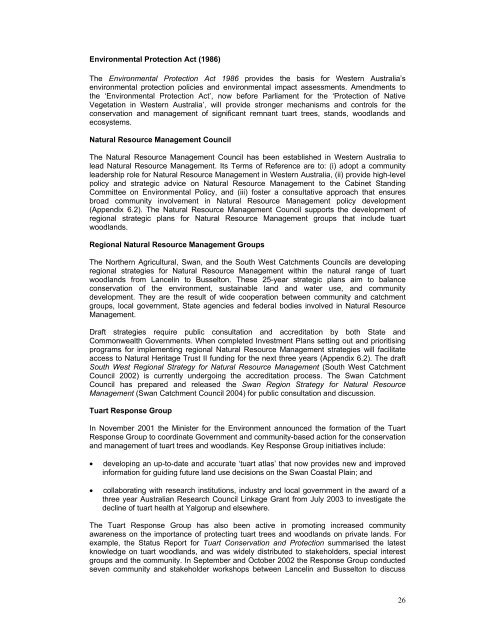DRAFT Tuart Conservation and Management Strategy
DRAFT Tuart Conservation and Management Strategy
DRAFT Tuart Conservation and Management Strategy
Create successful ePaper yourself
Turn your PDF publications into a flip-book with our unique Google optimized e-Paper software.
Environmental Protection Act (1986)<br />
The Environmental Protection Act 1986 provides the basis for Western Australia’s<br />
environmental protection policies <strong>and</strong> environmental impact assessments. Amendments to<br />
the ‘Environmental Protection Act’, now before Parliament for the ‘Protection of Native<br />
Vegetation in Western Australia’, will provide stronger mechanisms <strong>and</strong> controls for the<br />
conservation <strong>and</strong> management of significant remnant tuart trees, st<strong>and</strong>s, woodl<strong>and</strong>s <strong>and</strong><br />
ecosystems.<br />
Natural Resource <strong>Management</strong> Council<br />
The Natural Resource <strong>Management</strong> Council has been established in Western Australia to<br />
lead Natural Resource <strong>Management</strong>. Its Terms of Reference are to: (i) adopt a community<br />
leadership role for Natural Resource <strong>Management</strong> in Western Australia, (ii) provide high-level<br />
policy <strong>and</strong> strategic advice on Natural Resource <strong>Management</strong> to the Cabinet St<strong>and</strong>ing<br />
Committee on Environmental Policy, <strong>and</strong> (iii) foster a consultative approach that ensures<br />
broad community involvement in Natural Resource <strong>Management</strong> policy development<br />
(Appendix 6.2). The Natural Resource <strong>Management</strong> Council supports the development of<br />
regional strategic plans for Natural Resource <strong>Management</strong> groups that include tuart<br />
woodl<strong>and</strong>s.<br />
Regional Natural Resource <strong>Management</strong> Groups<br />
The Northern Agricultural, Swan, <strong>and</strong> the South West Catchments Councils are developing<br />
regional strategies for Natural Resource <strong>Management</strong> within the natural range of tuart<br />
woodl<strong>and</strong>s from Lancelin to Busselton. These 25-year strategic plans aim to balance<br />
conservation of the environment, sustainable l<strong>and</strong> <strong>and</strong> water use, <strong>and</strong> community<br />
development. They are the result of wide cooperation between community <strong>and</strong> catchment<br />
groups, local government, State agencies <strong>and</strong> federal bodies involved in Natural Resource<br />
<strong>Management</strong>.<br />
Draft strategies require public consultation <strong>and</strong> accreditation by both State <strong>and</strong><br />
Commonwealth Governments. When completed Investment Plans setting out <strong>and</strong> prioritising<br />
programs for implementing regional Natural Resource <strong>Management</strong> strategies will facilitate<br />
access to Natural Heritage Trust II funding for the next three years (Appendix 6.2). The draft<br />
South West Regional <strong>Strategy</strong> for Natural Resource <strong>Management</strong> (South West Catchment<br />
Council 2002) is currently undergoing the accreditation process. The Swan Catchment<br />
Council has prepared <strong>and</strong> released the Swan Region <strong>Strategy</strong> for Natural Resource<br />
<strong>Management</strong> (Swan Catchment Council 2004) for public consultation <strong>and</strong> discussion.<br />
<strong>Tuart</strong> Response Group<br />
In November 2001 the Minister for the Environment announced the formation of the <strong>Tuart</strong><br />
Response Group to coordinate Government <strong>and</strong> community-based action for the conservation<br />
<strong>and</strong> management of tuart trees <strong>and</strong> woodl<strong>and</strong>s. Key Response Group initiatives include:<br />
• developing an up-to-date <strong>and</strong> accurate ‘tuart atlas’ that now provides new <strong>and</strong> improved<br />
information for guiding future l<strong>and</strong> use decisions on the Swan Coastal Plain; <strong>and</strong><br />
• collaborating with research institutions, industry <strong>and</strong> local government in the award of a<br />
three year Australian Research Council Linkage Grant from July 2003 to investigate the<br />
decline of tuart health at Yalgorup <strong>and</strong> elsewhere.<br />
The <strong>Tuart</strong> Response Group has also been active in promoting increased community<br />
awareness on the importance of protecting tuart trees <strong>and</strong> woodl<strong>and</strong>s on private l<strong>and</strong>s. For<br />
example, the Status Report for <strong>Tuart</strong> <strong>Conservation</strong> <strong>and</strong> Protection summarised the latest<br />
knowledge on tuart woodl<strong>and</strong>s, <strong>and</strong> was widely distributed to stakeholders, special interest<br />
groups <strong>and</strong> the community. In September <strong>and</strong> October 2002 the Response Group conducted<br />
seven community <strong>and</strong> stakeholder workshops between Lancelin <strong>and</strong> Busselton to discuss<br />
26

















